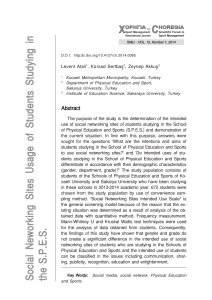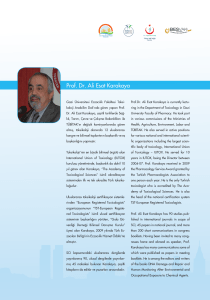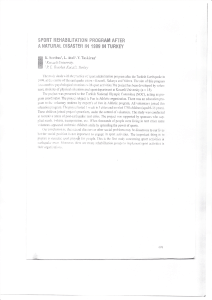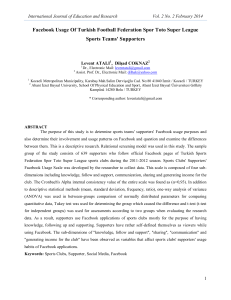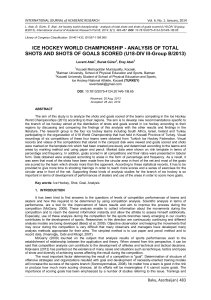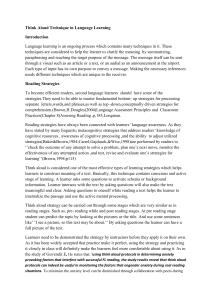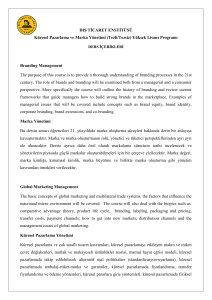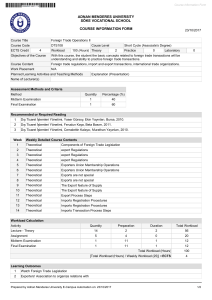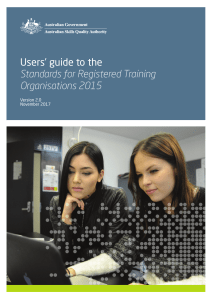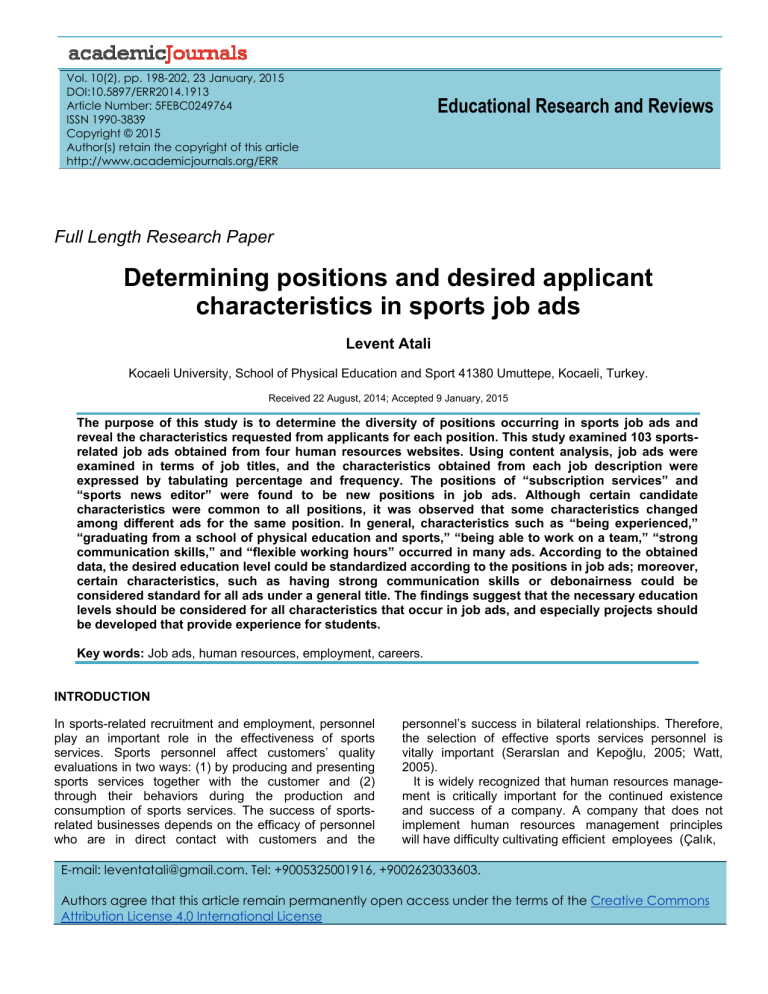
Vol. 10(2), pp. 198-202, 23 January, 2015
DOI:10.5897/ERR2014.1913
Article Number: 5FEBC0249764
ISSN 1990-3839
Copyright © 2015
Author(s) retain the copyright of this article
http://www.academicjournals.org/ERR Educational Research and Reviews
Full Length Research Paper Determining positions and desired applicant
characteristics in sports job ads
Levent Atali
Kocaeli University, School of Physical Education and Sport 41380 Umuttepe, Kocaeli, Turkey.
Received 22 August, 2014; Accepted 9 January, 2015
The purpose of this study is to determine the diversity of positions occurring in sports job ads and
reveal the characteristics requested from applicants for each position. This study examined 103 sportsrelated job ads obtained from four human resources websites. Using content analysis, job ads were
examined in terms of job titles, and the characteristics obtained from each job description were
expressed by tabulating percentage and frequency. The positions of “subscription services” and
“sports news editor” were found to be new positions in job ads. Although certain candidate
characteristics were common to all positions, it was observed that some characteristics changed
among different ads for the same position. In general, characteristics such as “being experienced,”
“graduating from a school of physical education and sports,” “being able to work on a team,” “strong
communication skills,” and “flexible working hours” occurred in many ads. According to the obtained
data, the desired education level could be standardized according to the positions in job ads; moreover,
certain characteristics, such as having strong communication skills or debonairness could be
considered standard for all ads under a general title. The findings suggest that the necessary education
levels should be considered for all characteristics that occur in job ads, and especially projects should
be developed that provide experience for students.
Key words: Job ads, human resources, employment, careers.
INTRODUCTION
In sports-related recruitment and employment, personnel
play an important role in the effectiveness of sports
services. Sports personnel affect customers’ quality
evaluations in two ways: (1) by producing and presenting
sports services together with the customer and (2)
through their behaviors during the production and
consumption of sports services. The success of sportsrelated businesses depends on the efficacy of personnel
who are in direct contact with customers and the
personnel’s success in bilateral relationships. Therefore,
the selection of effective sports services personnel is
vitally important (Serarslan and Kepoğlu, 2005; Watt,
2005).
It is widely recognized that human resources management is critically important for the continued existence
and success of a company. A company that does not
implement human resources management principles
will have difficulty cultivating efficient employees (Çalık,
E-mail: [email protected]. Tel: +9005325001916, +9002623033603.
Authors agree that this article remain permanently open access under the terms of the Creative Commons
Attribution License 4.0 International License
Atali
2006, as cited in Karakaya et al., 2013). Recruiting
personnel, locating personnel resources, and ensuring
continuity are some of the important functions of human
resources.
The selection process involves determining the most
appropriate job candidate among several applicants in
terms of qualifications (Yüksel, 2003). Recruitment, as
one of the most important areas of human resources
management, can be defined as hiring employees who
not only meet the qualifications for the job but will also
contribute to the future success of the company. In the
recruitment process, candidates who can perform the
work must first be identified, and then the most
appropriate applicant must be selected (Basım and
Argan, 2009). This process, which comprises an important
area of study in human resources, includes determining
personnel needs, announcing this need using the
appropriate means, receiving applications, recruiting
candidates, and hiring the appropriate applicants
(Fındıkçı, 2012). Job descriptions, requirements, and
qualifications should be introduced during the search
process, and they should be calibrated to find the right
personnel for the position (Yüksel, 2003).
Ideally, job requirements and candidate qualifications
will be compatible during the personnel selection stage.
When applicants’ qualifications fall short of the job’s
requirements, the wrong personnel are recruited for the
position. In such cases, restarting the selection process
will cost the organization additional time and money
(Basım and Argan, 2009).
Job ads are of particular concern to candidates who
seek employment or want to change jobs. Newspapers,
periodicals, and websites are known as places where job
ads are easily found. The descriptions of job titles,
qualifications, and requirements that appear in such ads
have great importance (Latif and Uçkun, 2004). Further, it
should be noted that equal job opportunities are available
to all applicants regardless of gender, marital status,
pregnancy, religion, or race (Department of Sport and
Recreation, 2003).
Many recent studies have emphasized the importance
of career training along with innovations in the field of
education (cited by Karakaya et al., 2013; Rojewski and
Kim, 2003). Various educational approaches can help
students to find jobs and be successful in their careers.
To improve curricula, academicians plan courses covering
leadership, management, personality, and human
relations. Factors such as internships, friends, teachers,
families, and counselors have great influence over career
choices (Mathner and Martin, 2012). Aytac (2005, as
cited in Karakaya et al., 2013) defined career as involving
many processes covering experiences and attitudes in a
person’s business life, which the person will always have
to face throughout his or her professional career. In
addition, Mafini et al. (2013) noted five important factors
for job satisfaction: working conditions, ability utilization,
teamwork, creativity, and autonomy.
The skills needed for a successful career in sports
199
marketing are attention to detail, passion, flexibility,
communication, interpersonal skills, organizational skills,
and individual trust (www.career.opcd.wfu.edu). Karakaya
et al. (2013) found that, for students, possessing
knowledge and information about their skills and career
values will help them find a career they will be happy to
have throughout their lives. People should seek to make
the best professional choices for themselves by comparing their personal skills and values when evaluating
and deciding upon their career paths.
The problem of finding appropriate and effective
personnel applies to businesses of all sizes and sectors
(Fındıkçı, 2012). This study sought to determine the
diversity of positions specific to sports services jobs and
discover the characteristics of those positions based on
applicant requirements stated in the job ads.
METHOD
The model of the research
Content analysis, one of the qualitative research methods, is based
on acquisition of systematic and common data about the content of
a large number of texts (Gokce, 2006). Document screening (web
page) was performed in this study in order to obtain data from a
large number of texts systematically based on content analysis.
Study group
This study examined 103 sports-related job ads obtained from four
human resources websites between November 1 and 25, 2013.
These websites can be considered the most comprehensive job
sites on the Internet; they were selected as appropriate for the
scope of this study since they contain all job ads found on many
other smaller websites for this field.
Data collection tool
Human resources websites publishing job ads in Turkish language
were identified and determined by making search on search engine
websites through internet. Four websites among those were
examined by the aid of a form prepared and issued by the
researcher. The following questions took place in the context of the
draft form prepared by the researcher: For which position is the job
ad about on the website? What are the qualifications and desired
characteristics demanded for the position? In addition, other
available information found while examining the job ads on
websites were recorded. Different positions stated in the province
ads and the qualifications and desired characteristics demanded for
the position were obtained as the result of that examination.
Data analysis
Data were classified in the qualitative research and divided into
clusters in accordance with their similarities and differences.
Categories were formed or it was benefited from available
categories during that process (Kus, 2006). In this study, available
job ads were evaluated as position titles and the qualifications and
desired characteristics were evaluated as categories and subcategories. In addition, job ads published within the dates mentioned
in the study performed based on content analysis method were
200
Educ. Res. Rev.
Table 1. Distribution of positions in job ads (n = 13).
Name of position
Fitness instructor
Physical education and sports teacher
Coach
Sports instructor
Lifeguard
Animator
Masseur/masseuse
Pilates instructor
Sports manager
Swimming instructor/coach
Subscription services
Gymnastics instructor/coach
Sports news editor
Total
F
30
13
10
9
8
6
6
6
4
4
3
2
2
103
%
29.1
12.6
9.7
8.7
7.7
5.8
5.8
5.8
3.8
3.8
2.9
1.9
1.9
100
examined as positions and the desired characteristics and
qualifications that will be requested from candidates were
determined in each position description. The desired characteristics
and qualifications derived from each position description were
expressed in tables by the terms of frequency and percentage. The
importance and state were determined in accordance with the
density of the characteristics and qualifications mentioned above.
RESULTS
In this section, job positions and their characteristics were
tabulated according to the obtained data, and descriptions
were developed related to the results.
As shown in Table 1, the analyzed ads covered 13 job
positions. The top three positions were fitness instructor
(29.1%), physical education and sports teacher (12.6%),
and coach (9.7%). Positions that occurred less frequently
included sports news editor (1.9%), gymnastics instructor
(1.9%), and subscription services (2.9%).
For the position of fitness instructor, the top
characteristics included flexible working hours (9.7%),
being able to work on a team (9.2%), being experienced
(8.6%), graduating from a school of physical education
and sports (8.1%), and debonairness (7.6%). Near the
bottom were characteristics such as having at least a
high school education(1.0%), graduating from a school of
physical education and sports or being certified (1.0%),
being able to orient oneself to intense work pressure
(1.0%), and nonsmoker (1.0%).
The top characteristics for physical education and
sports teachers included graduating from a school of
physical education and sports (21.6%), being experienced
(13.3%), and having strong communication skills (13.3%).
The bottom characteristics included having organizational
skills (1.6%), being dynamic (1.6%), and knowing English
(1.6%).
For the position of coach, graduating from high school
(15.6%), being certified (2.5%), and having a high sense
of responsibility (9.3%) were the top characteristics. The
lowest included having an aptitude for dancing (3.1%),
having knowledge about football (3.1%), and being open
to learning (3.1%).
For sports instructors, the most frequently mentioned
characteristics included having strong communication
skills (14.2%), graduating from a school of physical
education and sports or being a student in such a school
(9.5%), and being open to learning (9.5%). The least
mentioned characteristics included having proficiency with
computers (2.3%), being responsive (2.3%), and having
knowledge of more than one sport (2.3%).
The top characteristics for lifeguards included having a
lifeguard certificate (22.8%), having graduated high
school (11.4%), and having good human relations skills
(8.5%). The lowest included having strong communication
skills (2.8%), being a nonsmoker (2.8%), and having
good diction (2.8%).
For animators, the top characteristics included being
experienced (15.1%), having good human relations
(12.1%), and knowing German and English (12.1%). The
bottom included having organizational skills (3.0%),
having aptitude for dancing (3.0%), and knowing English
(3.0%).
The top characteristics for masseur/masseuse included
being certified (20.0%), being experienced (16.6%), and
giving importance to personal appearance (10.0%). The
least mentioned characteristics included having at least a
high school diploma (3.3%), having no military service
problems (3.3%), and being solution oriented (3.3%).
For the position of gymnastics instructor/coach, having
graduated from a school of physical education and sports
or being a current student in such a school was the single
characteristic (100%).
For Pilates instructors, the top characteristics included
being experienced (13.3%), having good human relations
(10.0%), and being presentable (10.0%). The bottom
included graduating from a school of physical education
and sports (3.3%), having knowledge of more than one
type of sport (3.3%), and knowing English (3.3%).
The top characteristics for sports managers included
being experienced (21.0%), graduating from a school of
physical education and sports (15.7%), and having strong
communication skills (15.7%). The bottom characteristics
included being open to learning (5.2%), having organizational skills (5.2%), and being dynamic (5.2%).
For the position of swimming instructor/coach, the top
characteristics included graduating from a school of
physical education and sports (16.6%), being experienced
(16.6%), and being able to work on a team (11.1%). The
least mentioned characteristics included having proficiency with computers (5.5%), being dynamic (5.5%),
and being cooperative (5.5%).
For jobs in subscription services, the most mentioned
characteristics included having proficiency with computers
Atali
201
Table 2. General distribution of the characteristics of the positions
Characteristics
Being experienced
Graduating from a school of physical education and sports
Being able to work on a team
Having strong communication skills
Flexible working hours
Debonairness
Good human relations
Being open to learning
Being certified
Being presentable
Graduating from a school of physical education and sports or being enrolled in such a school
Giving importance to personal appearance, having a strong sense of responsibility, knowing English, being dynamic
Having at least a high school diploma, being proficient with computers
Having a lifeguard certificate, being cooperative
Having no military service problems
Having good diction, being able to orient oneself to intense work pressure
Preferably know English
Know German and English
Having strong communication skills with children, having organizational skills, nonsmoker, preferably graduating from a
school of physical education and sports, preferably knowing a foreign language
Having knowledge of aerobics, graduating from a school of physical education and sports or being certified, having
knowledge of more than one area of sports, being disposed to work with children, being social and enjoyable, having at
least a high school diploma, having interest in various areas of sports, having graduated from a university, having an
aptitude for dancing
Graduating from a school of physical education and sports or from a faculty of tourism, being solution oriented, having
knowledge of football, having a first aid certificate, being patient, being receptive
(13.0%), being experienced (13.0%), and knowing English
(13.0%). The least mentioned characteristics included
graduating from a school of physical education and
sports or from a faculty of tourism (4.3%), being dynamic
(4.3%), and having strong communication skills (4.3%).
The top characteristics for sports news editors included
being interested in various types of sports (25.0%),
graduating from a university (25.0%), and knowing
English (12.5%). The bottom included being experienced
(12.5%), having proficiency with computers (12.5%), and
having a high sense of responsibility (12.5%).
Examining the distribution of characteristics for all
positions (Table 2), being experienced, graduating from a
school of physical education and sports, being able to
work on a team, having strong communication skills, and
debonairness appeared with the highest frequency.
DISCUSSION AND CONCLUSION
Many special features were identified in the ads for the
thirteen sports-related positions examined in this study.
Following the stated purpose of the research, the results
showed the diversity of positions appearing in sports job
F
56
44
41
36
32
29
26
22
21
20
19
16
10
9
8
6
5
4
3
2
1
ads and identified the features requested from applicants
for each position.
The requirement that candidates for coach positions be
“high school graduates” has implications for individuals
currently enrolled in undergraduate education since being
a high school graduate is considered sufficient for the job.
Asking that lifeguard applicants be certified was an
expected result given the potential legal liabilities that
accompany such work. The characteristic of “being
experienced” for animators and Pilates instructors can be
interpreted as stemming from the implementation-based
nature of the work. The requirement that masseur/
masseuse applicants “be certified” pertains to the
documentation requirements for such work. “Being
proficient with computers” was expected for subscription
services jobs since the work is mostly performed using
computers.
The results showed that desired characteristics varied
according to position, and a characteristic that was
important for one position might have been be less so for
another. Certain characteristics, such as “good human
relations” and “debonairness,” could be subject to
evaluation during the interview process or during the trial
period of employment. Bravo et al. (2012) suggested that
202
Educ. Res. Rev.
various elements are important during the employment
process. The primary elements include work ethic,
communication skills, motivation, maturity, thinking ability,
decision-making skills, human relations, technical skills,
and naturalness. Other elements include experience,
leadership skills, references, undergraduate education,
certification, participation in sports, and academic
achievement. Many of these characteristics were
observed as important in the job ads examined for this
study.
Characteristics that appeared frequently such as
“graduating from a school of physical education and
sports,” “being experienced,” “being able to work on a
team,” and “having strong communication skills” warrant
attention. A preference for candidates who have
graduated from a school of physical education and sports
can be viewed as appropriate for businesses operating in
sports-related services. Taşmektepligil et al. (2009)
supported this preference, noting that individuals
educated in sports and physical education has a more
intense orientation toward sports activities. With increased
public interest in sports and physical activities, problems
that arise are more likely to be resolved if priority is given
to candidates with a sports-related education. Meanwhile,
job experience (“being experienced”) has been mentioned
in the selection criteria for candidates who apply for jobs
in the Department of Sport and Recreation (2003).
Patterson and Allen (1996) defined certain skills for job
success in the new millennium, placing emphasis on
teamwork (“being able to work on a team”). Lastly, NACE
(2005) found that employers emphasize communication
and teamwork skills in hiring candidates and in their
continued employment (Doğu et al., 2013).
In their study of the career skills needed for success in
the administration of school sports, Won et al. (2013)
found that work experience, motivation, education,
leadership skills, academic achievement, and professional
suitability were the main factors affecting recruitment. In
addition, human-interaction skills, compliance, conceptual
skills, creativity, and technical skills have been revealed
as effective factors for successful administrative management. Furthermore, Vilorio (2012) found that coaches
require interpersonal, decision-making, and leadership
skills, among others, to develop their athletes. Lastly,
executives at different levels in various organizations
related to physical education have been found to require
conceptual skills, humanitarian skills, and technical skills
(cited by Benar et al., 2014; Goodarzy, Kouzechian and
Ehsani, 2003).
This study’s analysis of sports job ads revealed that
“subscription services” and “sports news editor” have
emerged as new areas of sports-related employment.
These new jobs can be viewed as creating new opportunities for careers in sports. In general, while certain
characteristics were common to all positions, some
characteristics changed among different ads for the same
position. According to the data obtained in this study, the
desired level of education can be standardized according
to job position. Further, characteristics such as having
strong communication skills or debonairness may be
viewed as typical for all job ads under a general title.
Necessary educational attainment should be considered
for all characteristics that occur in job ads. In particular,
projects should be developed that provide experience for
students.
Conflict of Interests
The author has not declared any conflict of interests.
REFERENCES
Basım N, Argan M (2009). Spor yönetimi. Ankara: Detay Yayıncılık.
Benar N, Nejad R, Surani M, Rostami H, Yeganehfar N (2014).
Designing a managerial
skills model for chief executive officers
(CEOs) of professional sports clubs in Isfahan Province. Sport Sci.
Rev. 23(1-2):59-77. http://dx.doi.org/10.2478/ssr-2014-0004
Bravo G, Won D, Shonk D (2012). Entry-level employment in
intercollegiate athletic
departments: Non-readily observable and
readily observable attributes of job candidates. J. Sport Adm.
Superv. 4(1):63-78. http://hdl.handle.net/2027/spo.6776111.0004.110
Department of Sport and Recreation (2003). Selection and recruitment
of sport and
recreation personnel. Government of Western
Australia,
Australia.
http://fulltext.ausport.gov.au/fulltext/2003/wa/Personnel.pdf
Doğu G, Sevimli D, Durusoy A (Eds.). (2013). Çağdaş spor yönetimi.
İstanbul: Gendaş Yayıncılık.
Fındıkçı İ (2012). İnsan kaynakları yönetimi. İstanbul: Alfa Yayınları.
Gokçe O (2006). İçerik analizi, kuramsal ve pratik bilgiler. Ankara:
Siyasal Kitapevi.
Karakaya Y, Karataş Ö, Özdenk Ç, Karataş F (2013). Üniversiteli
öğrencilerin kariyer değeri algıları. Doğuş Üniversitesi Dergisi
14(1):86-94.http://journal.dogus.edu.tr/index.php/duj/article/view/670
Kus E (2006). Sosyal bilimlerde bilgisayar destekli nitel veri analizi.
Ankara: Anı Kitapevi.
Latif H, Uçkun G (2004). İş ilanı nasıl yanıtlanır? İstanbul: Rota
Yayınları.
Mafini C, Surujlal J, Dhurup, M (2013). The relationship between job
satisfaction and job loyalty among municipal sports officers. Afr. J.
Phys.
Health
Educ.
Recreat.
Danc.
19(1):12-29.
http://www.ajol.info/index.php/ajpherd/article/view/87567
Mathner RP, Martin, CLL (2012). Sport management graduate and
undergraduate students’ perceptions of career choices in sport
management.
Sport
Manag.
Educ.
J.
6(1):21-31.
http://journals.humankinetics.com/smej-back-issues/smej-volume-6issue-1-october/
Patterson V, Allen C (1996). Occupational outlook overview: Where will
the jobs be in 2005? J. Career Plan. Employ. 56(3):32-35.
Serarslan Z, Kepoğlu A (2005). Spor örgütlerinde toplam kalite.
İstanbul: Morpa Yayınları.
Taşmektepligil Y, Hazar F, Ağaoğlu A, Öğreten N, Terzioğlu A (2009).
Beden eğitimi ve spor alanı mezunlarının istihdam sorunları ve yeni iş
olanakları. Erzincan Eğitim Fakültesi
Dergisi
11(2):99-118.
http://eefdergi.erzincan.edu.tr/issue/view/1006000094
Vilorio D (2012). More than play: Three careers in sports. Occup.
Outlook Q. 56(2):2-11. http://www.nata.org/sites/default/files/MoreThan-Play-3-Careers-in-Sports.pdf
Watt D (2005). Sports management and administration. London:
Routledge.
Won D, Bravo G, Lee C (2013). Careers in collegiate athletic
administration: Hiring criteria and skills needed for success. Manag.
Leis. 18(1):71-91. http://dx.doi.org/10.1080/13606719.2012.742222
Yüksel Ö (2003). İnsan kaynakları yönetimi. Ankara: Gazi Kitapevi.

